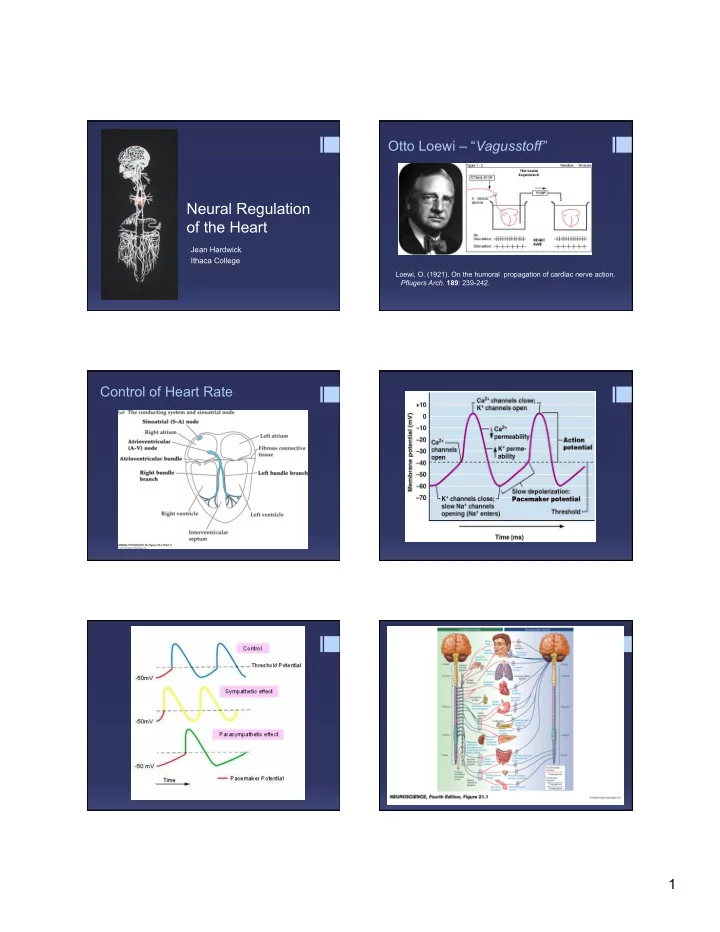

Otto Loewi – “ Vagusstoff” Neural Regulation of the Heart Jean Hardwick Ithaca College Loewi, O. (1921). On the humoral propagation of cardiac nerve action. Pflugers Arch. 189 : 239-242. Control of Heart Rate 1
Cardiac Ganglion Preganglionic neuron Postganglionic neuron Target Target Sensory innervation CNS Preganglionic Neurons Sensory Inputs • BP Sympathetic Postganglionic • pH Fibers • pO 2 Parasympathetic Postganglionic Neurons Cardiac Sensory Neurons Cardiac Target Cells Parasympathetic Cardiac Ganglion Neuropeptides Neuropeptides Fast synaptic transmission (ionotropic) Sensory peptides (sensory neurons from spinal ACh (nicotinic receptors) cord) Other signals (metabotropic) Substance P CGRP ACh (muscarinic receptors) PACAP (neurons from brainstem, neurons within NE ganglion) Neuropeptides PACAP38, PACAP27 Locally-generated signals PACAP 1-27 28-38 Nitric Oxide (NO) Inflammatory signals 2
Nitric Oxide Nitric Oxide NOS Three isoforms of nitric oxide synthase Ca ++ Neuronal NOS (nNOS) Endothelial NOS (eNOS) NO Inducible NOS (iNOS) Guanylate Cyclase cGMP Cardiac Mast Cells Parasympathetic Cardiac Ganglion Found in high density in mammalian heart Stimulated by: Mast cells Preganglionic Fibers Antigen exposure Postganglionic Fibers Sensory neuropeptides Chemoreceptors Sympathetic pH changes, low oxygen Postganglionic Fibers Upon stimulation, release Histamine Prostaglandins Sensory Afferents Model System Guinea pig cardiac ganglion Mawe, et al (1996) Cell Tissue Res 285:281. 3
MAP2 Substance P Histamine PACAP 27 MAP2 MAP2 4
Guinea pig cardiac ganglion Nitric Oxide in the Heart “puffer” containing test substance Neuromodulation Acute changes Changes in excitability Preganglionic fiber Changes in sensitivity to individual chemicals Postganglionic neuron Changes in synaptic function Long term changes Phasic Neuron Tonic Neuron Changes in phenotype Histamine Depolarization Mechanism? 5
Sodium Channels: Ion substitution Membrane Depolarization Amplitude Duration N Control Control 5.6 ± 2.8 46.9 ± 29.4 19 14 Histamine, # 12 # AP Frequency (Hz) 50% NMG 4.0 ± 1.5 54.3 ± 18.4 6 10 # # 8 100% NMG 2.0 ± 1.1 33.9 ± 35.1 9 # 6 # 4 2 0 0.0 0.2 0.4 0.6 Stimulus (nA) Excitability Changes: Ion Channel Inhibitors Barium How can you change the firing Blocks many K channels, including some properties of a neuron? leakage channels and m-current 4-aminopyridine What ionic mechanisms could Blocks A-current (K channel) produce this? TEA Blocks some Ca-dependent K channels Cs Blocks H-current (hyperpolarization- activated cation channel) Control Cs + Ba 2+ 4-AP 1 mM 4-AP 1 mM Cs + 5 mM TEA 1 mM Ba 2+ TEA 6
Muscarinic Receptors Remove Preganglionic fibers (from brainstem) external Ca 2+ ACh - nicotinic (fast) and muscarinic (slow) Bethanechol – muscarinic agonist Control 200 µ M Cd 2+ Beth Adrenergic Receptors Single Action Potentials Adrenergic postganglionic fibers NE – increase excitability Control NE PACAP 7
Synaptic Function Excitability Changes Histamine Dependent on influx of extracellular Calcium ions TRPC channel? Muscarinic (bethanechol) TEA-sensitive channels BK channels? M-current? Adrenergic Preganglionic fiber Calcium-dependent Indirect inhibition of BK channels? Postganglionic neuron VDCC? Neuropeptides PACAP H channels, Calcium-dependent mechanism Long term changes: Remodeling Synaptic Transmission Nitric Oxide Chronic heart disease Number one cause of death in the United EPSP States Amp (mV) 2010 data: 595,444 deaths due to heart disease 4.1 + 1.6 Control ~24% of all deaths (N=6) Ischemic heart disease (heart attacks) most common form 7.4 + 3.5 * SNP (N=6) How does neuronal control of the heart change with chronic heart * p < 0.02, paired T test disease? 8
Models of Heart Disease Regulation of NOS levels Myocardial infarction (MI) Ligate left ventricular coronary artery 6-9 weeks recovery Pressure Overload (PO) Band descending dorsal aorta Produces left ventricular hypertrophy 8-10 weeks recovery Control Chronic MI Sham surgery nNOS Horackova, M. et al. (2004) Am J Physiol Heart Circ Physiol 287: and H1599-H1608 MAP2 Regulation of NOS levels Synaptic Function 5 ¡ IHC - % nNOS Neurons qPCR – nNOS mRNA 4.5 ¡ 25 Control Rela9ve ¡Change ¡in ¡mRNA ¡Expression ¡ 4 ¡ MI # Sham surgery 20 3.5 ¡ PO # 3 ¡ %nNOS cells 15 2.5 ¡ 2 ¡ 10 1.5 ¡ 1 ¡ Preganglionic fiber 5 0.5 ¡ 0 ¡ 0 Control ¡ Sham ¡ MI ¡ PO ¡ Postganglionic neuron Synaptic Function Synaptic Function • EPSPs • Suprathreshold stimulations • 20 Hz, 2 sec duration CONTROL MI PO FTS 20 Hz RMP (mV) -49.5 ± 7.9 -41.8 ± 5.8 -46.7 ± 9.1 EPSP amplitude (mV) 6.8 ± 0.4 6.6 ± 0.6 5.6 ± 0.8 N 17 19 17 No significant differences 9
What could produce this change in synaptic function? Synaptic Changes No changes in EPSP amplitudes with chronic disease No apparent changes in synaptic function in animals with MI Enhanced synaptic function ONLY in animals with PO Increased function is not inhibited by atropine (not due to increased sensitivity to muscarinic activity) Drug Treatment Drug Treatment Implant osmotic pump NE blocker Induce heart disease Timolol Blocks β -adrenergic 2 weeks later, implant receptors pump Total drug treatment period of 6 weeks Control animals, just drug, no disease 10
Adrenergic Blocker: Timolol Adrenergic Blocker: Timolol MI Time Course MI Time Course Induce MI Examine tissue at 4 Days 7 Days 14 Days Student Collaborators Acknowledgements National Institutes of Health Heart, Lung, and Blood Institute Shannon Ryan ‘12, Kristen Levin ’12, Rod Parsons - UVM Natasha Petersen ‘12, Rich Kintzing ‘12 Jeffrey Ardell – ETSU Chris Palmer ‘11, Samantha Corrado ‘11, Phil Feinberg ‘11 Marie Southerland, DVM – ETSU Not Pictured: Caitlin Baran ‘09 Lauren Houdek ’09 Stephanie Hinsvark ‘12 Melanie Powers Fraites ‘01, Ally Girasole ‘10 11
The Heart Nebula…….. 12
Recommend
More recommend